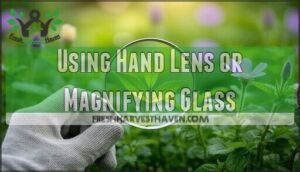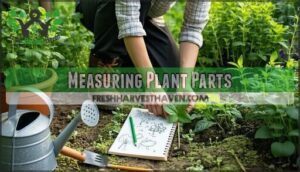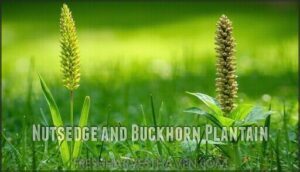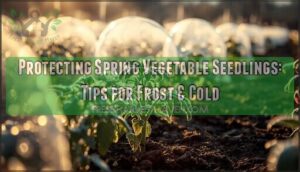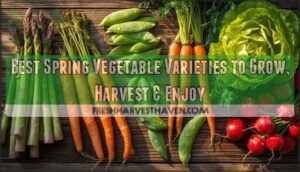This site is supported by our readers. We may earn a commission, at no cost to you, if you purchase through links.
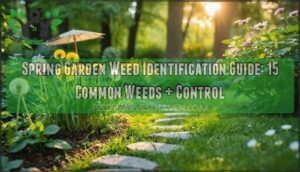
Spotting weeds early makes all the difference. Get to them before they dig in, and you’ll save your garden from having its nutrients stolen while keeping aggressive spreaders from muscling out the plants you actually want to grow.
From dandelions spreading their umbrella seeds to crabgrass creeping through lawn gaps, each weed has telltale characteristics that reveal its identity and weakness.
Table Of Contents
- Key Takeaways
- Garden Weed Basics
- Weed Identification Methods
- Common Spring Weeds
- Weed Prevention Strategies
- Effective Weed Control
- Frequently Asked Questions (FAQs)
- How do weather conditions affect weed growth patterns?
- When is the best time for weed identification?
- Do certain weeds indicate specific soil deficiencies?
- How long do weed seeds remain viable underground?
- When do spring weeds typically start emerging?
- How often should I inspect for weeds?
- What weather conditions encourage weed growth most?
- Can weeds return after complete removal?
- Which spring weeds are safe to eat?
- Conclusion
Key Takeaways
- Early identification saves your garden – Catching weeds before they establish deep roots prevents them from stealing up to 30% of your garden’s nutrients and water, making spring the crucial time for spotting troublemakers.
- Know your enemy types – Annual weeds complete their life cycle in one season but produce thousands of seeds, while perennial weeds return year after year with stubborn root systems that require different control strategies.
- Prevention beats treatment – Using weed-free mulch, pre-emergent herbicides when soil hits 50°F, and maintaining thick, healthy lawns creates natural barriers that stop weeds before they start.
- Use the right identification tools – Hand lenses reveal key features like leaf margins and growth patterns, while plant identification apps like PictureThis achieve 78% accuracy for reliable species identification.
Garden Weed Basics
Garden weeds are unwanted plants that compete with your desired flowers and vegetables for nutrients, water, and space.
Annual weeds live for just one season, while perennials come back every year. Knowing which type you’re dealing with makes all the difference in how you tackle them effectively.
Definition of Garden Weeds
Picture this: you’re admiring your carefully planned garden when you spot an uninvited guest that seems to grow twice as fast as anything you actually planted. That’s a garden weed—any plant growing where you don’t want it.
These unwelcome visitors compete aggressively for water, nutrients, and sunlight that your prized plants need. Some are invasive species that cause serious ecological damage by crowding out native plants. Others are noxious weeds that create health hazards or economic impact through reduced crop yields.
Knowing how these persistent troublemakers work gives you the upper hand. Once you understand their growth patterns, reproduction cycles, and vulnerabilities, you can stop them before they turn your garden sanctuary into their personal kingdom.
Types of Weeds
Not all weeds are created equal, and knowing the difference between a stubborn dandelion and an invasive poison ivy can save you hours of frustration. Annual weeds complete their life cycle in one season, while perennial weeds return year after year with established root systems. You’ll also encounter broadleaf weeds with wide, flat leaves and grassy weeds that mimic your lawn.
- Annual weeds die after one season but often produce thousands of seeds
- Perennial weeds store energy in deep roots, making them harder to eliminate
- Noxious weeds are legally designated as harmful to agriculture or ecosystems
Importance of Weed Identification
Catching weeds early saves your garden from disaster. Quick identification prevents invasive species from establishing deep roots and spreading throughout your landscape. When you spot weeds before they mature, you stop costly damage that can reduce crop yields by up to 52%. Understanding weed ecology helps you target specific threats effectively. Effective weed management relies on weed identification techniques to develop a successful control plan.
| Identification Factor | Impact | Management Benefit |
|---|---|---|
| Early Detection | Prevents seed production | Reduces future infestations |
| Species Recognition | Targets control methods | Minimizes herbicide resistance |
| Growth Pattern Analysis | Predicts spread rate | Protects ecological balance |
| Timing Assessment | Optimizes intervention | Cuts economic impacts |
| Visual Documentation | Tracks problem areas | Improves garden weeds control |
Weed Identification Methods
Getting weed identification right means looking closely at the specific details that make each plant unique.
Having the right tools and knowing what to look for helps you catch these weeds early, before they spread throughout your garden.
Using Hand Lens or Magnifying Glass
Think of yourself as a detective examining evidence at a crime scene—every tiny detail on a weed can reveal its true identity. A hand lens or magnifying glass becomes your essential botany tool for plant examination. You’ll spot key leaf margins, intricate growth patterns, and seed observation details that separate look-alikes.
Here’s what magnifying techniques help you examine:
- Leaf shape variations and serrated edges
- Tiny hairs on stems and undersides of leaves
- Vein patterns that distinguish similar species
- Surface textures through detailed leaf inspection
- Small flowers or seed structures for plant identification
Measuring Plant Parts
Getting your measurements right can mean the difference between confidently identifying that troublesome weed and letting it slip through your fingers for another season. Accurate leaf measurement and botanical sizing help distinguish similar species through precise plant scaling.
- Use a standard ruler for consistent leaf shape documentation
- Record growth pattern dimensions at multiple plant development stages
- Compare flower calibration measurements against identification guides
Once you start measuring consistently, plant identification stops being a guessing game. You’ll have the data you need to make confident calls.
Observing Leaf Arrangement and Margin
Think of each leaf as nature’s fingerprint. Every weed species leaves its own calling card in how leaves attach to stems and what their edges look like. You’ll notice some leaves grow directly across from each other, others spiral up the stem one by one, and some form little circles around it.
Edge styles tell their own story too—from perfectly smooth borders to jagged saw-tooth patterns that help you tell lookalikes apart.
| Feature | What to Look For |
|---|---|
| Leaf Shapes | Heart-shaped, lance-like, or lobed patterns |
| Margin Types | Smooth, toothed, or deeply cut edges |
| Petiole Length | Short stems versus long leaf stalks |
| Tip Characteristics | Pointed, rounded, or notched leaf tips |
When you combine vein patterns—whether they run parallel like grass or branch out like a river delta—with all these visual clues, identifying garden weeds becomes much more straightforward.
Utilizing Plant Identification Apps
Gone are the days of flipping through field guides and playing guessing games with garden weeds. Plant identification apps have changed everything.
Three standout options consistently nail the identification of common garden weeds:
Modern plant identification apps transform weed identification methods from guesswork to science. Three apps consistently deliver reliable results for identifying common garden weeds:
- PictureThis achieves 78% accuracy with extensive database coverage and AI integration
- PlantNet offers 68% accuracy plus offline access for mobile accessibility
- iNaturalist provides community verification and detailed user reviews
These tools excel at visual identification of weeds, though accuracy drops with young seedlings. For accurate plant identification, using a reliable app guide is essential.
Common Spring Weeds
Spring brings a parade of unwelcome guests to your garden, each with its own tricks for taking over your carefully tended space.
Knowing how to spot these common invaders early gives you the upper hand in keeping your garden healthy and thriving.
Poison Sumac and Poison Ivy
Spring’s toxic duo—poison sumac and poison ivy—demands your immediate attention for safe Weed identification. These plants cause severe Allergic Contact Dermatitis through urushiol exposure, affecting over 80% of people.
Poison sumac’s compound leaves feature 7-13 leaflets with red veins, while poison ivy displays three-leaflet clusters. Both require specialized Weed Control Techniques and Skin Irritation Treatment knowledge for effective Toxic Plant Identification.
Dandelion and Plantain
Who knew that two of spring’s most notorious "weeds" could actually be your garden’s secret pharmacy? Dandelion identification starts with their hollow stems and bright yellow blooms, while plantain shows distinctive parallel leaf veins. Both complete their weed life cycle early, making spring garden maintenance vital for control.
Essential dandelion and plantain facts:
- Dandelion seeds spread rapidly via wind dispersal
- Plantain uses include natural wound healing properties
- Both weeds indicate compacted soil conditions
- Early identification prevents lawn care headaches later
Crabgrass and Quackgrass
Nobody wants these grassy invaders taking over their lawn. Crabgrass germinates when soil temperatures reach 55°F, forming dense mats that smother desirable grass. Quackgrass spreads through underground rhizomes up to 11 feet long, making its removal particularly challenging.
| Feature | Crabgrass | Quackgrass |
|---|---|---|
| Identification | Flat blades, spreads along ground | Blue-green leaves with clasping auricles |
| Spread Method | Seeds (150,000 per plant) | Rhizomes and fragments |
| Control Timing | Pre-emergent in early spring | Mechanical removal required |
For effective crabgrass control and weed prevention, apply pre-emergent herbicides before soil temperatures consistently reach 55°F. Your lawn maintenance strategy should focus on maintaining dense turf through proper fertilization.
Nutsedge and Buckhorn Plantain
Two sneaky troublemakers often masquerade as harmless lawn residents, but their triangular stems and ribbed leaves give them away every time. Nutsedge stands tall with its three-sided stems and yellowish spikes, thriving in wet spots where your lawn struggles. Buckhorn Plantain spreads its narrow, ribbed leaves in a tight rosette, sending up slender seed heads that resist mowing.
These invasive species demand different approaches—Nutsedge Control requires specialized herbicides, while Buckhorn Removal responds well to hand-pulling when soil is moist.
Weed Prevention Strategies
Stopping weeds before they start saves you tons of work later. I’ve learned to focus on four things that really make a difference: walking through my garden weekly to spot trouble early, using only clean mulch and compost (trust me on this one), applying pre-emergent herbicide in spring before those seeds wake up, and keeping my grass thick enough that weeds can’t muscle their way in.
Prevention beats treatment in dealing with garden weeds. Smart gardeners use four key strategies: regular inspections to catch problems early, weed-free materials like clean mulch and compost, pre-emergent herbicides that stop seeds before they sprout, and healthy lawns that naturally crowd out unwanted plants.
Regular Garden Inspection
Think of your garden as a battlefield where early detection wins the war against weeds. Daily walks through your spring garden let you spot troublemakers before they establish deep roots or spread seeds. Regular garden inspection becomes your first line of defense in weed control, helping you create accurate plant records and seasonal checks for better garden monitoring.
Key inspection practices include:
- Weed mapping problem areas to track recurring issues and target future treatments
- Inspection schedules during peak growing seasons when weeds emerge most rapidly
- Tool sanitation between garden areas to prevent spreading seeds and plant diseases
Using Weed-Free Mulch and Compost
Smart gardeners know that the best defense against weeds starts with what you spread on top of your soil. Weed-free mulch and compost create effective weed barriers while boosting soil health.
Choose quality organic matter like aged bark or leaf mold—these soil amendments block sunlight and retain moisture.
Apply a 2-3 inch layer for ideal mulch benefits, securing your organic methods work double duty preventing weeds and feeding plants.
Applying Pre-Emergent Herbicides
Pre-emergent herbicides work like a bouncer at your garden’s door—they stop troublemakers before they can even get inside. These weed prevention strategies create an invisible barrier in soil that blocks seeds from sprouting. Proper application timing matters—apply when soil hits 50°F in spring for greatest weed control effectiveness.
Here’s your herbicide application game plan:
- Choose your weapon: Granular formulas last longer; liquid versions work faster
- Time it right: Apply 2-4 weeks before weeds usually emerge in your spring garden
- Handle with care: Wear gloves and follow label instructions to minimize environmental impact
Remember, preemergent herbicides won’t affect existing weeds—they’re purely preventative. This approach helps reduce weed resistance while protecting your garden’s ecosystem.
Maintaining Healthy Lawns
A thick, vibrant lawn acts like nature’s own armor against weeds, creating such fierce competition that most unwanted plants can’t get a foothold. Here’s how to build that defense:
- Soil Health – Test annually and adjust pH between 6.0-7.0
- Proper Mowing – Cut at highest recommended height for your grass type
- Lawn Aeration – Core aerate compacted areas each spring
- Overseeding Lawns – Fill bare spots before spring weeds arrive
- Deep watering – Water less frequently but thoroughly to encourage deep roots
When you nail down all five steps, your grass grows thick enough to crowd out weeds naturally. Dense turf leaves no room for unwanted seeds to sprout and take hold.
These preventive measures create dense turf that naturally suppresses weed germination and establishment.
Effective Weed Control
Once you’ve spotted those spring weeds, it’s time to take action before they spread and steal nutrients from your garden plants.
You’ll need different tactics for different weeds—some respond well to hand-pulling, while others require herbicides or smothering techniques to knock them out for good.
Digging and Pulling Weeds
When spring weeds have already taken root, getting down and dirty with your hands often beats any chemical solution you can buy. Proper tools like a weeder or dandelion knife make digging easier and more effective.
Technique matters – loosen soil around the weed first, then pull slowly to make certain of complete root removal. This prevents regrowth while minimizing soil disturbance around desirable plants.
Smothering and Herbicide Application
Sometimes the gentlest approach proves most effective—smothering weeds cuts off their lifeline while herbicides deliver a targeted knockout punch. Smothering materials like landscape fabric or cardboard block sunlight, weakening spring weeds over time.
For herbicide selection, choose organic options or glyphosate-based products. Application timing matters—treat actively growing weeds during calm weather.
Consider environmental impact and practice resistance management by rotating control methods.
Managing Troublesome Weeds Like Japanese Knotweed
Japanese knotweed identification starts with recognizing its heart-shaped leaves and bamboo-like stems that can reach 10 feet tall.
Control strategies must address its extensive root system, which spreads up to 7 meters horizontally. Professional herbicide treatments starting at £1,900 offer the most effective long-term monitoring approach.
Environmental impact includes nutrient cycle disruption and biodiversity loss. Legal ramifications can affect property values by over £170 million annually in the UK.
Weed eradication techniques require persistent, integrated approaches combining chemical and mechanical methods for successful invasive plants management.
Organic Methods for Weed Suppression
You don’t need to be a chemist to win the war on weeds. Nature has plenty of tricks up her sleeve that work just as well as anything you’ll find at the garden center.
The secret is knowing which method works best at different points in a weed’s life cycle.
Your garden doesn’t need a chemistry degree to stay weed-free—Mother Nature’s toolkit works just as well as any store-bought spray. These organic weed control methods create natural barriers and competition that weeds simply can’t overcome. The key is understanding how each technique targets different stages of weed growth.
- Mulch Types – Apply 3-inch layers of wood chips, straw, or shredded leaves around plants to block sunlight and prevent spring garden weeds from germinating.
- Solarization Benefits – Cover problem areas with clear plastic during summer heat to naturally sterilize soil and eliminate dormant weed seeds without chemicals.
- Cover Cropping – Plant dense crops like winter rye or crimson clover to outcompete weeds for space, nutrients, and water while improving soil health.
- Natural Herbicides – Use white vinegar solutions or boiling water for spot treatments on persistent weeds like dandelions and crabgrass.
- Companion Planting – Design dense plantings where vegetables and flowers crowd out weeds naturally, maximizing your garden’s productive potential while minimizing weed identification challenges.
Frequently Asked Questions (FAQs)
How do weather conditions affect weed growth patterns?
Like clockwork, temperature impacts and rainfall influence determine which weeds dominate your garden. Spring weeds emerge when soil conditions warm.
Seasonal variations from climate change create unpredictable weed identification challenges during the critical seedling stage.
When is the best time for weed identification?
Most gardeners find success identifying weeds during peak growing season when distinctive features like flowers and mature leaves are fully visible.
Early detection at the seedling stage, combined with regular garden inspection frequency, helps catch common spring weeds before they establish deep root systems.
Do certain weeds indicate specific soil deficiencies?
Certain weeds act as natural soil deficiency indicators, revealing underlying garden conditions. Clover signals low nitrogen levels, while moss thrives in acidic, compacted soil.
Dandelions prefer heavy clay, and purslane indicates rich, fertile ground with adequate moisture.
How long do weed seeds remain viable underground?
Against all expectations, those troublesome weed seeds you pulled last season might still be plotting their comeback decades from now. Seed dormancy duration varies dramatically—lambsquarters can survive over 40 years underground, while most species germinate within 1-5 years depending on soil conditions and environmental factors.
When do spring weeds typically start emerging?
Most weeds begin emerging when soil temperatures consistently reach 50-55°F, usually occurring between late February and early April depending on your location.
Regional variations and weed life-cycles determine specific emergence timing patterns.
How often should I inspect for weeds?
Before smartphones made plant identification instant, gardeners relied on weekly walks through their plots.
Check your garden every 3-5 days during peak growing season for ideal weed identification and early detection. This regular lawn care schedule catches weed seed germination before spring garden invaders establish deep roots, making weed control and weed management much easier.
What weather conditions encourage weed growth most?
Warm temperatures combined with adequate soil moisture create perfect conditions for weed growth. Temperature fluctuations between 60-80°F, consistent rainfall patterns, and high humidity levels accelerate germination. Wind dispersal spreads seeds rapidly across garden beds.
Can weeds return after complete removal?
Unfortunately, weeds often return after removal due to persistent root systems and soil seed banks. Research shows that soil can contain up to 140,000 weed seeds per square meter, creating ongoing regeneration patterns. Effective weed control requires understanding these mechanisms:
- Perennial weeds store energy in deep root systems, allowing regrowth from remaining fragments
- Seed bank persistence means dormant seeds germinate for years after initial removal
- Incomplete removal techniques leave root portions that regenerate into new plants
- Poor soil quality creates conditions favoring weed establishment over desired plants
The key to beating weeds long-term? You need to pull them out completely AND keep an eye on your soil health.
Successful weed management combines thorough removal with ongoing monitoring and soil improvement strategies.
Which spring weeds are safe to eat?
Several common spring weeds offer excellent nutrition when properly identified. Dandelions provide vitamins A and C, while chickweed and purslane deliver omega-3 fatty acids.
Always verify identification before foraging any wild greens for safety.
Conclusion
Studies show that weeds can steal up to 30% of your garden’s nutrients and water, making early detection vital for plant health.
Your spring garden weed identification guide becomes your roadmap to garden success—knowing which invaders you’re facing means choosing the right battle strategy.
From pulling annual weeds before they spread to attacking perennial roots at their source, proper identification saves time, money, and your sanity. Master these techniques, and you’ll transform from reactive gardener to proactive garden guardian.
Master weed identification early, and you’ll save your garden from nutrient thieves while transforming from reactive gardener to proactive guardian
- https://extension.umd.edu/resource/spring-weeds
- https://extension.psu.edu/early-spring-weeds-in-no-till-fields/
- https://gardentherapy.ca/types-of-weeds/
- https://projectblue.blob.core.windows.net/media/Default/Imported%20Publication%20Docs/Weed%20identification%20pocket%20guide.pdf
- https://extension.usu.edu/yardandgarden/research/landscape-and-garden-weed-control

